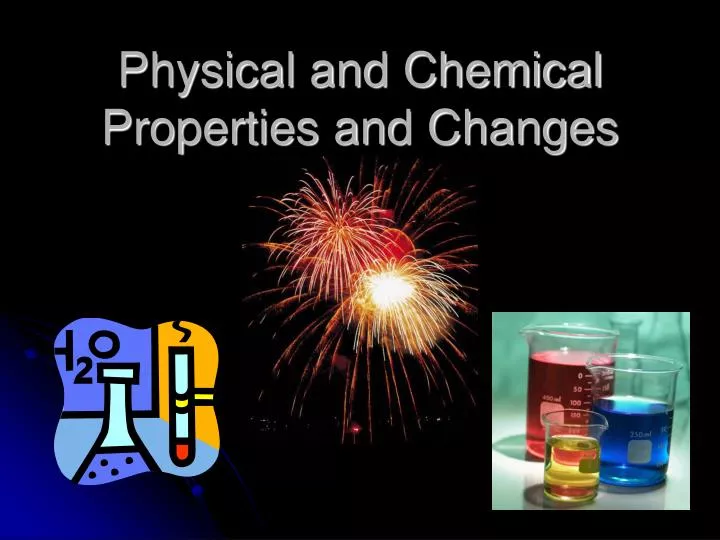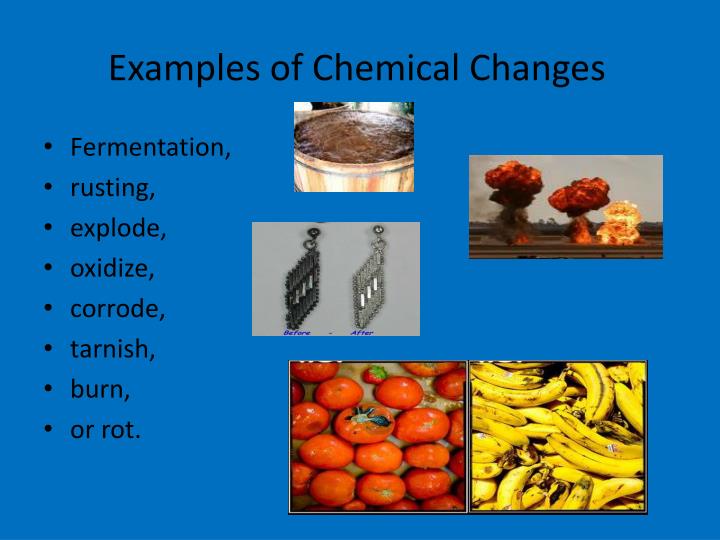
- #PHYSICAL AND CHEMICAL PROPERTIES AND CHANGES HOW TO#
- #PHYSICAL AND CHEMICAL PROPERTIES AND CHANGES CODE#
Temperature of the melting point apparatus is below 100 oC.

Tap the open end of a melting point tube intoĮach of your unknowns so that about 2 to 3 mm height of your unknown is in the Unknowns on a piece of weighing paper or onto a watch glass. Based on this data alone, indicate whether A bright light indicates that the solid is anĮlectrolyte no light at all indicates that the substance is a nonelectrolyte. Solution resulted in the light shining brightly, dimly, or not at all.
#PHYSICAL AND CHEMICAL PROPERTIES AND CHANGES HOW TO#
Your instructor will show you how to measure Solution even though the sample may not completely dissolve. The mixture thoroughly for 1 to 2 minutes and test the conductivity of the If the solid does not dissolve after the addition of 20-mL of water,ĭiscontinue the addition of water and record the fact that the solid did notĭissolve after the addition of 20 mL of water in your record book. Of water required to dissolve each solid. Increments until all the solid has dissolved and then record the total volume If after 2 minutes the solid has not allĭissolved, add another milliliter of water and repeat the stirring Graduated cylinder and stir the mixture with a stirring rod.

Place 0.25 g of the solid in a medium size Numbers of your unknowns in your record book.įor each unknown determine the solubility
#PHYSICAL AND CHEMICAL PROPERTIES AND CHANGES CODE#
Obtain 2 unknowns from your instructor and record the code Literature to identify your unknown substances.īe careful not to burn yourself with either the Bunsenĭo not breathe the vapors of the solids as you attempt toīurn them burn them near or under a snorkel.

The properties that you observed in lab with those that you found in the Use include The Handbook of Chemistry and Physics, The Merck Index, or you may The properties of these substances in the literature. To do this you will be given a list of substances from which your substance was Physical and chemical properties can sometimes be used to Set of properties is used to characterize the substance as ionic or When molecular compounds do dissolve in water, they do not conductĮveryone of the “usual” properties associated with ionic and molecularĪ substance as ionic or molecular several properties must be determined and the Have low melting points, often less than 300 oC, are usually lessĭense than ionic compounds, and are often less soluble in water than ionicĬompounds. Consequently, molecular compounds usually Weaker than the ionic bonds that hold ionic compounds together. Intermolecular forces are also electrostatic in nature, but are much Liquid) state by attractions between these molecules called intermolecularįorces. Soluble in water, conduct electricity when in aqueous solution or molten, andĬompounds consist of neutral molecules that are held together in the solid (or Ionic compounds are those consisting ofĬations and anions which are bonded to each other by electrostatic attractions.Ĭompounds usually have high melting points, in excess of 300 oC, are often Physical and chemical properties can be used to classify a Substance, either with itself or with another substance are chemical Such as melting point, boiling point, density, solubility, color, odor, etc.ĭescribe how a substance changes identity to produce a new substance are That can be determined without changing the composition of a substance are Known substances in order to identify the unknown substances.Īll substances can be characterized by their unique sets of

The main objective of this experiment is to experimentallyĭetermine several chemical and physical properties of two unknown compounds andīased on the set of properties identify each substance as either ionic orĬompare chemical and physical properties of unknown substances with those of


 0 kommentar(er)
0 kommentar(er)
